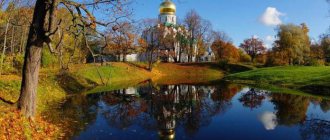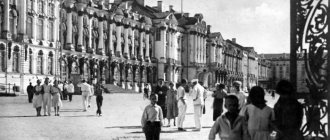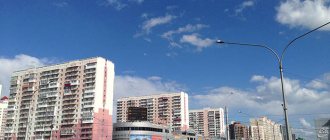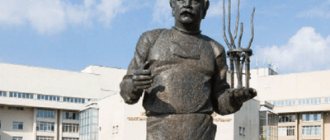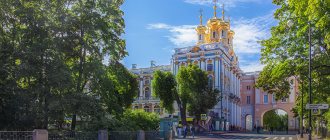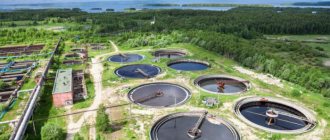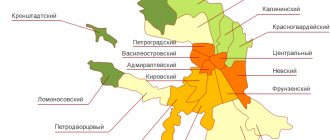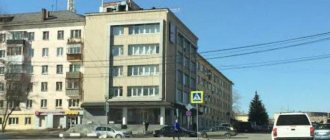Founding history
A Swedish magnate lived here from 1609 to 1702. His small estate was called Sarskaya Manor. It included a wooden house and utility buildings, a neat garden with two perpendicular paths dividing the territory into 4 squares.
The first mention of this village is contained in a document dating back to 1501. Then Peter I expelled the Swedish population and took possession of this land, transferring it into the hands of A. Menshikov. On June 13, 1710, this point appears under the name Tsarskoe Selo. It was presented to M. Skavronskaya, later the emperor’s wife Ekaterina Alekseevna. This moment is considered the founding date of Pushkin. At that time it played the role of a country residence.
Medium-sized cities 20-100 thousand people
Coat of arms of Peterhof
Peterhof
Population 78,457 people (2016).
Founded in 1705 as a “travel yard” (Petrov yard - German: Peterhof
), in 1710 the construction of the world-famous country residence of Peter I began here. The city has been in operation since 1762.
The Peterhof palace and park ensemble is famous for its numerous parks, ponds, canals and, most of all, intricate fountains and cascades of fountains. Here is the watch factory of the famous Raketa brand (founded in 1721 as the Peterhof Lapidary Factory). In the 1970s and 1980s. a suburban campus of St. Petersburg State University was built on the outskirts of the city. In 2005, Peterhof received the status of a science city. Coat of arms of Krasnoe Selo
Red Village
Population 54,422 people (2016).
Founded in 1714 by Peter I as a paper mill (factory) south of St. Petersburg, city since 1925. The settlement during the Imperial era was in the possession of the royal court. city since the year In the middle it turned into the summer military capital of the Russian Empire - large-scale military training and exercises took place here. For a long time there was a paper factory in the city, now there is a plastics factory on part of its territory.
Coat of arms of Lomonosov
Lomonosov (city)
Population 43,244 people (2016).
Founded in 1710 as Oranienbaum - the suburban residence of the first St. Petersburg governor A.D. Menshikov. City since 1780. Known for its palace and park ensemble - the largest ensemble of Peter the Great's Baroque in the suburbs of St. Petersburg. Due to the fact that Soviet troops managed to hold the famous Oranienbaum bridgehead during the Great Patriotic War, the city was not destroyed by the Germans, unlike the neighboring palace and park residences located along the famous Peterhof road.
Coat of arms of Kronstadt
Kronstadt
Population 43,005 people (2010).
Founded in 1704 as a fortified city on Kotlin Island in the Gulf of Finland, guarding the approaches to St. Petersburg. Already under Peter I it became a base for the Baltic Fleet and continues to play this role to this day. In 1983, Kotlin Island was connected to the mainland from the north by a dam along which a highway ran. In 2011, the dam also approached the city from the south.
Coat of arms of Sestroretsk
Sestroretsk
Population 40,090 people (2016).
Founded in 1714 as the country residence of Peter I, the city since 1925. In 1721-1724. The Sestroretsk arms factory was built here, along with a dam that formed a large reservoir. The plant was one of the main military-industrial enterprises of the Russian Empire, producing cannons, firearms, as well as civilian products. At the end of the 19th century, Sestroretsk turned into a dacha and sanatorium-resort area.
Improvement of the object
In the period 1718-1724. The construction of the palace and the auxiliary buildings surrounding it was carried out. They were surrounded by the greenery of a picturesque garden. Between 1719 and 1722 created 2 ponds on the terrace below.
A settlement was built nearby for the palace employees. In 1716, the Assumption Church appeared. The first street, which appeared in 1720, was Sadovaya (previously called Perednyaya). During 1721, the Kuzminskaya Sloboda was established. The peasant population of the Suzdal province lived in it.
The oldest building made of stone, the Znamenskaya Church, began to be built in 1734. The city appeared here in 1808. The local museum-reserve has become a monument to urban planning. The ensemble of the 18th-20th centuries, including the park and the Catherine Palace, as well as the buildings adjacent to them, deserves no less attention.
Catherine Palace – history and exhibitions
The compositional center of the Tsarskoye Selo ensemble is the Catherine Palace. In 1717-1714. the architect Braunstein built a rather modest stone palace for Empress Ekaterina Alekseevna, wife of Peter the Great. This palace was inherited by their daughter Elizabeth, who, having come to power, began to vigorously rebuild and expand it. In the 1740s, M. G. Zemtsov, A. V. Kvasov, S. I. Chevakinsky worked on the reconstruction, and from 1748 to 1756, F.-B. had the honor of building the current version of the palace. Rastrelli. The luxurious grand palace in the Baroque style suited the tastes of the royal owner. After her death, the next ruler, Catherine the Second, in the 1770s commissioned the architect Charles Cameron to remodel her personal chambers in the palace in accordance with the new fashion for antiquity. Further, under Alexander I, the emperor’s rooms in the palace were remodeled by V.P. Stasov, and the last reconstructions in the palace took place during the time of Alexander II in the 1860s. All these interiors, carefully restored by our restorers after destruction during the Great Patriotic War, can be seen during an excursion to the Catherine Palace.
Area, relief and climate
The area of the city of Pushkin is 201 square meters. km. It is located on the territory of the Prinevskaya lowland, to the left of the river. Not you. There are various landscape forms: plains, ridges, terraces, valleys and hills. Forests are mixed with agricultural land.
The city of Pushkin (St. Petersburg) is home to springs that feed ponds and streams. 350 million years ago (Paleozoic) there was a sea here. Clay, sands, limestone, and sandstones have survived to this day. Their layer reaches 200 m and covers a crystalline diabase, gneiss, and granite foundation. The formation of the current relief was stimulated by a cover of ice (the Valdai glaciation, which occurred 12,000 years earlier).
When thawing occurred, the Littorine Sea appeared, whose depth was 8 m greater than the current one. 4000 years ago the tide ebbed and the river appeared. The Neva is the result of post-glacial deposits. For 2.5 thousand years, right up to the present day, no changes in relief were noticed.
The local climate is characterized by moderation and humidity. It is transitional between continental and maritime. Summer doesn't last long and it's rarely hot. The winter is much longer, interrupted by thaws.
The transition periods of spring and autumn are long, so average indicators are more common for local residents. Temperatures are above freezing between April and November. The coldest month is February. The annual precipitation level is 590 millimeters.
Atmospheric currents, as a rule, are clean and fresh, enter here from the south, due to which the weather is mild. One air mass can quickly give way to another. Cyclones are frequent. The sun is least in November-January. In general, the local climate is quite comfortable for life.
Territorial division
You can get to the city center of Pushkin if you move northeast from the park area. It is mainly built up with buildings of 3-4 floors made of stone. Most of them were built in the pre-revolutionary period.
The main historical district is Sofia. Next to it are the streets. Parkovaya and Sapernaya, Pavlovskoye and Krasnoselskoye highways. Krasnoselka previously housed Arakcheevka, Babolova and Soboleva - private areas of the city. Pushkin is a place where, while exploring, you will stumble upon the Friedenthal colony, which belonged to the Germans. A large number of high-rise buildings on the territory of BAM. There was a private sector here. Also worthy of attention are Novaya Derevnya and Belozerka, Novoselki, which grew out of rural areas. Another historical district is Kondakopshino. In addition, there are zones called Pavlovsk-2, Lesnoye (belongs to the GPP), Novokondakopshino.
Many people may be interested in the question of which index to use? The city of Pushkin is divided into only 2 postal areas, so departments accept letters using the details: 196601 or 196609.
How to get there from St. Petersburg?
There are several ways to get to the city of Pushkin: by private transport, by bus or minibus, by train. The latter run from Vitebsky railway station and from the Kupchino railway station. Travel time ranges from 15 to 30 minutes, ticket price ranges from 50 rubles. According to the schedule, there are more than 40 trains a day, so the waiting time for transport will be a maximum of 30 minutes.
The following buses and minibuses go along this route:
- from the Moskovskaya metro station – No. 187, K-287, K-342, K-347a, K-545;
- from the Kupchino metro station - No. K-286, K-347, K-342, K-545a;
- from the Zvezdnaya metro station – No. 179, 186, K-363.
The distance from St. Petersburg to Pushkin is 30 km.
National characteristics
A 19th century guidebook indicates that the population of Pushkin (St. Petersburg) was 15 thousand people. It was unlike other cities in terms of its ethnic composition.
Bourgeois, peasant people, clergy and merchants made up 7 thousand people. The remaining half consisted of military personnel, courtiers, and colonists. It was not just a quiet place to live, but an important political point.
Local society had a special coloring. Many St. Petersburg residents came here for 3 months and left the city. In 1939, in the Leningrad region, as in the entire Soviet Union, a population census was carried out, the results of which revealed that 17,711 thousand Jews lived here. When the Germans occupied the city, they were almost completely destroyed.
Dynamics of population change
At the beginning of the 18th century, the Sarskaya manor included more than 43 villages, 6 wastelands, peasant and bobil households. Over time, the population grew. During the reign of Peter I, 200 peasant families lived here.
The composition of the village included the church parable, guard soldiers and court servants. New villages arose, where there were 71 households, consisting of immigrants and 69 from the local population.
In 1732, a census was carried out, according to the results of which there were 48 men here. In the surrounding villages, they counted 105 Latvian households, in which representatives of the stronger and fairer sex lived in a ratio of 336/343, respectively. In 1796, the Palace Settlement included 779 buildings in which 2.8 thousand people lived. Sofia became home to 1.6 thousand people. (146 dwellings).
In 1845, Colonel Zhukovsky made a report in which it was reported that, including the garrison, the population was 121.94 thousand people. Of these, 9.066 thousand were men, 3.128 thousand were women. Hundreds of families came here in the summer to relax together with the courtyard. Workers (1-1.5 thousand people) also went to Tsarskoye Selo.
royal residence
The story of Pushkin is well known to most of our readers, so there is probably no need to retell it. The first associations are Alexander Sergeevich and “our fatherland, Tsarskoe Selo.” The imperial palaces of Catherine and Alexander, parks also come to mind...
There are no very old buildings left here, apart from the former royal chambers - everything was erected in the 20th century and later.
Chinatown on the shores of the Gulf of Finland, or Who should buy housing in the “Baltic Pearl” The “Baltic Pearl” project was launched in 2005. Today, the implementation of the first major integrated development project in St. Petersburg is nearing completion. Let's go and see what was built. >>The housing construction boom occurred in the 70s, but, characteristically, houses were not built from panels - only brick. The trend lost its relevance only in the 90s, when standard buildings of the 600.11 series began to appear in Pushkin. It is interesting that at the same time, private cottages were built en masse: among wealthy people with a dubious past, Pushkin was popular even then.
But basically the Soviet housing stock is represented by five-story brick buildings of the 528 series. It is in them that the most affordable supply on the secondary market is now concentrated (see table). But, of course, we must take into account that this, to put it mildly, is not the most comfortable housing: tiny kitchens and bathrooms, low ceilings.
The second wave of the construction boom hit Tsarskoye Selo, as we already mentioned, at the beginning of the 21st century. More than 6 thousand apartments were sold in local new buildings, and, of course, some of them entered the secondary market, raising the average price in this location to the level of Vasilyevsky Island (140 thousand rubles).
XX - early XXI centuries
In 1909 there were 31,201 thousand people here. Of these, 2.8 thousand were noble class, 309 were clergy, 691 were citizens with an honorary title, 241 were merchants, 2.505 thousand were bourgeois, 13.653 thousand were peasants, 52 were colonists, 8.169 thousand were military personnel. , 1.369 thousand were retirees. Foreigners with families – 237 people. Other population groups – 209 people.
The number of people increased, and within a century there were 108.3 thousand people here. 93.8 thousand people lived directly in the city of Pushkin.
The territories of Pavlovsky and Pushkinsky districts were united into a single administrative unit. In 2001, the total number of people was 124.3 thousand citizens.
In 2002, a count was carried out again, showing a total of 116,811 thousand (in the Pushkinsky district there were 100,097 thousand people). Of these, 56% were of working age. This was the moment of the first positive changes in the birth rate (it increased by 5%).
Subsequently, positive population dynamics were observed: 2003 – 84.6 thousand people, 2006 – 110.9 thousand people.
Moving discord
Pushkin, both in Soviet times and now, is valued for its excellent transport accessibility. The oldest railway in the country, new trains and frequency of trains make the half-hour journey to Vitebsky Station quite convenient. As an alternative, there are minibuses and buses going to the Moskovskaya metro station either along Vitebsky Prospekt or along Pulkovskoye Shosse.
The only, and quite important, problem is the lack of overpasses over the railway (or tunnels under it), which cuts the city into two unequal parts. Unfortunately, it has not yet been possible to solve it - there is not even a project.
There is also a certain lack of social infrastructure. It is aggravated by the fact that residents of Slavyanka, Lensovetovsky and Shushar bring their children to Pushkin, where the situation with schools and kindergartens is even worse. There is no normal shopping and entertainment complex or hypermarkets in the city. This is especially strange considering that about 100 thousand people now live here.
Closer to our days
The number of people living here has changed due to the rapid development of construction.
According to 2008 data, 1.278 thousand people were born, which exceeded the results of 2007. However, in order for Pushkin’s population to reproduce properly, the figure had to double. 285 people born from extramarital unions. In 60% of cases, both parents applied for registration.
In 2009, 1,471 couples entered into a marriage union, and 742 were dissolved.
There are more women than men. Of the total number, they are 54%, which is 4.5 thousand people. exceeds the number of representatives of the stronger sex. These are mostly people of non-working age. Representatives of the fair sex live longer.
The population of Pushkin has an average age of 40 years. Based on demographic and social indicators, we can talk about its aging. If the trend does not change, senior citizens will soon make up a third of the total population. In 2009, 19,316 thousand foreigners registered for migration. 1,377 people came here in search of work, 435 people received Russian citizenship.
Since 2012, a steady increase in the number of people has been noticeable:
- in 2012, the population of Pushkin was 95.239 thousand people;
- 2013 – 97.34 thousand people;
- 2014 – 100.753 thousand people;
- 2015 – 101, 101 thousand people.
In 2016, the population of Pushkin is 102.729 thousand people. Of these, 63% are able-bodied. 13% are still too young to work, 24% are already old.
Alexander and Catherine parks in Tsarskoe Selo
The landscape gardening ensembles of Tsarskoye Selo clearly illustrate the development of fashion and trends in garden art of the 18th-19th centuries. Catherine Park has its origins in the legendary Dutch woman's vegetable garden of the early 1700s; one way or another, the first gardeners who worked on the palace garden for Ekaterina Alekseevna were Dutch. In the mid-eighteenth century, the park was remodeled in the regular French style, and at the end of the century it was expanded to include former hunting grounds. The new part of the park was laid out by English gardeners in landscape style. In Alexander Park, Catherine the Second decided to pay tribute to the fashion for everything exotic and oriental: a Chinese village appeared there. During the reign of Nicholas the First, an admirer of the work of Walter Scott, the Arsenal, Chapelle and the White Tower appeared in Alexander Park - pavilions that seemed to have come straight from the pages of chivalric novels.
Social support measures
Regional and federal authorities are faced with numerous tasks, as a result of which Russia (the city of Pushkin, in particular) will be transformed in terms of demography. Considerable attention is paid to family issues and providing parents with financial assistance.
Families are paid 15 different subsidies. Assistance is provided in supporting children while studying at school. Organizations are developing that are involved in protecting society, improving the quality of life, creating educational institutions, centers for improving health and sports. Massive events are held that emphasize the benefits of starting a family.
Many more problems remain unresolved. It is extremely important to address them as soon as possible in order to ensure an increase in the working-age population, which the city of Pushkin (St. Petersburg) desperately needs. Social guarantees for families with children are important due to the growing number of elderly citizens. In this case, young couples will not be afraid of financial difficulties when having a child.
Ratna Chamber
Under the last two emperors of the Romanov dynasty, after numerous imitations of Europe and the East, everything national and Russian finally came into fashion. Nicholas and Alexandra, the last royal couple of Russia, were deeply religious people, and not far from the Alexander Palace, where they lived, construction began on the Fedorov Cathedral in the ancient Russian style. There was supposed to be a large complex of buildings around it with buildings for the clergy, barracks for the Cossack convoy and many others. Tsar Nicholas decided to make one of these white stone buildings a museum glorifying the feats of arms of the Russian army. The Sovereign's War Chamber was founded in 1913; the basis of the collection of the future museum was the collection of the wife of Pavel Tretyakov's brother. The inexorable course of history changed the original purpose of the museum - in 1914, an exhibition dedicated to the life and exploits of the Russian army during the First World War opened here. The museum was of no interest to the new government after the revolution and was disbanded. Since 2008, through the efforts of the team of the Tsarskoe Selo State Museum, the restoration of the Great War Museum has been underway. The War Chamber opened to the public in 2014 to mark the centenary of the First World War.
